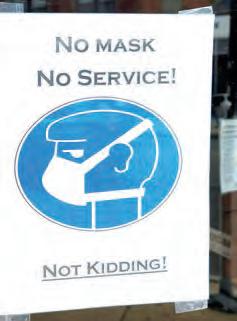
10 minute read
REVISITING REOPENING—See saw of reopening
REVISITING REOPENING

Closed, Open, Closed Again:
Seesaw Creates Tough Situation
| BY ED AVIS | Sabor a Mi Grill Tequila & Botanas in Rancho Cucamonga, California endured the initial COVID-19 shutdown that started in mid-March by offering takeout and delivery. When the state allowed a partial reopening in mid-June, owner Liz Hart reopened her patio and some tables inside, and quickly saw business return, especially on the weekends. But in early July, with rising infection numbers, the state again prohibited inside dining.
“The government just shut us again, and that’s been hard,” says Hart, whose patio remains open. “We had more hope before, but now it’s like we start from zero again.”
The seesaw of closing, opening, and closing again is taking its toll on restaurants nationwide. Now, many that were just starting to hear their cash registers ring again are returning to delivery-only models and wondering how long they can survive. In fact, data from Yelp in mid-July revealed that 16,000 restaurants of all types had closed permanently.
“W e ar e surviving,” Hart says. “But I don’t know what’s going on in the future.”
A LINGERING THREAT
Pepe Stepensky, a Mexican restaurant owner in the San Diego area, says customers were slowly returning to inside dining at his two Porkyland restaurants during the month they were open.
“Once they let us do the dining in, we put our tables and chairs back in at the distance they need to be, and star ted our marketing—‘Now open for dine-in,’ and things like that,”
–KARLA GARCIA, TECALITLAN MEXICAN RESTAURANT, Chicago
Stepensky says. “Customers were coming back, but not ‘Wow!’ People are very wary.”
When the state reclosed dining rooms, Stepensky was more prepared to deal with the situation than the first time his restaurants went dark. His delivery and carryout business has remained strong, and one of his Porkyland lo cations is in a shopping center with an open-air food court that r emains open to customers.
“I hope we keep incr easing sales,” Stepensky says. “But if there’s a second round of the pandemic as they predict for November and December and we have to close again it’s going to be really tough. It’s going to be a really close call.”
The threat of restaurants reclosing has even affected restaurants in areas that have not experienced the full seesaw situation. Chicago, for example, let restaurants par tially reopen dining rooms in June and has not closed them again. Nevertheless, with the continued uptick in confir med COVID cases, some owners are worried.
“We are constantly trying to figure out, ‘Are we going to get shut back down?’” says Karla Garcia, co-owner of Teca litlan Mexican Restaurant in Chicago. “We don’t want to get too much inventory . It is stressful because we don’t know what’s going to happen.”
ISSUES WITH STAFF A key concern for restaurants dealing with the seesaw situation is staffing. Some restaurants that furloughed employees during the height of the pandemic and rehir ed them when dining rooms reopened had to let them go again when dining rooms re-closed.
“When they closed us again, I had to tell my people that I had to be fair with ever ybody and give everyone even hours,” Hart says. “Some of them applied for unemployment again, so I let them take that money and I give those hours to the others.”
Gar cia, who r equired all of her staffers to be tested for COVID-19 before they returned to work, does not want to face letting them go again.
A BALANCING ACT There’s not much a restaurant owner can do to prevent the government from shutting things down again, but here are a few ways to ease the pain the ever-evolving situation has caused: • MAINTAIN YOUR TAKEOUT AND DELIVERY SERVICE EVEN
AFTER YOU’VE REOPENED THE DINING ROOM. That way you’ll be ready if you need to shut down again—and you may enjoy extra revenue in the meantime. Jim Ur diales, owner of Mestizo Restaurant in Baton Rouge, Louisiana, expanded his takeout business when restaurants shut down in March and has continued that even after the state allowed a partial reopening of dining rooms two months later. “We were shut down on March 16 and the next day we were full throttle to-go,” Urdiales says.
“To-go now is still 40 per cent of our sales, and with dining room at 50 percent capacity, we’re actually doing 100 per cent of the sales we wer e doing before COVID.” • MANAGE YOUR INVENTORY CAREFULLY. You probably always are careful with inventory, but that’s more important than ever when the risk exists that you could be shut down any day. Consider adjusting your menu to focus on items that are good for takeout and delivery so you can still use the ingredients if your dining room is closed. • KEEP YOUR EMPLOYEES AS SAFE AS POSSIBLE. In many areas, if a restaurant employee gets sick, the restaurant needs to shut down for a quarantine period, regar dless of the overall situation. “We’re trying to be as proactive as possible, because the last thing we want is to have to shut down for two weeks because someone gets sick,”
Garcia says.
The Mask Struggle

| BY ED AVIS | Karla Garcia remembers well the woman who ran into her restaurant, Tecalitlan Mexican Restaurant in Chicago, without a mask and asked for her takeout order. Garcia pointed to the “No Mask, No Service” sign and politely asked the woman to don her mask.
“But I’m just picking up my food,” the woman said. No dice , Garcia said. The woman walked out in disbelief, returned a minute later wearing a mask, and said, “You’re lucky, I had one in my car.” Garcia says she thought, “No, you’re lucky, because you weren’t going to get your food!” “I took the sign down and changed it to ‘No Mask, No Service, Not Kidding!’” Garcia says. Getting hassled by customers who don’t want to wear masks is an experience many Mexican r estaurant owners shar e. “It was very hard to make people wear a mask,” says Pepe Stepensky, owner of Porkyland, a Mexican r estaurant with two locations near San Diego. We tried to make them understand that it was for their own good.”Porkyland staff even offered custom ers clean, unused masks if they showed up without one. “A lot of people didn’t want to use them and said, ‘How do I know it hasn’t been used?’” Stepensky says. “It really was a headache.”
The bottom line is that r estaurant staff are more at risk than customers since they are exposed to the constant flow of guests. A guest who pops in for a minute—like the woman who came to pick up her order at Tecalitlan—is probably at little personal risk. But staff who are working with customers all day long are at risk if everyone is not wearing a mask.
“I feel bad for my staff, because not only are they serving, but they’re also trying to police the masks,” Garcia says. “We get put in a tough position. I tell people I’m just following the rules and trying to keep everybody safe. And people still don’t care. They say, ‘This is ridiculous.’ I tell them, ‘You’re being ridiculous. You just gotta wear it until you sit down, then you can take it off.’”
Mexican restaurant owners interviewed for this story offered a few tips for getting customers to wear the masks: • MAKE YOUR SIGNS OBVIOUS. Garcia says adding “Not Kidding” on her mask sign has helped. “People will try to run in—then they see the sign and stop dead in their tracks,” she says.

LET MANAGERS DEAL WITH UNMASKED CUSTOMERS. Don’t put your staff in the uncomfortable position of having to tell people without masks that they need to put one on—leave that up to management. At Maudie’s Tex-Mex, which has seven locations in Austin, managers politely explain the policy to anyone n o t wearing a mask. “We’ve had a couple of customers who come up without a mask, and when a manager explains to them that this is our policy, they under stand that,” says Elisa Munoz, Maudie’s dir ector of human resources. OFFER DISPOSABLE MASKS. Have a basket of disposable masks, preferably individually wrapped, available for customers who show up without masks. That eliminates the excuse of not having one. REFUSE SERVICE. Everybody needs customers, especially now. But as a last resort, you may need to ask a non-wearer to leave. “I feel like I repeat myself 50 times a day about wearing masks,” Garcia says. “I want to say, ‘You either want to eat here or not, buddy!’”
“Crisis Management Team” Helps Chronic Tacos Manage COVID Situation
| BY ED AVIS | When the COVID-19 crisis took hold across America in mid-March, restaurants scrambled to get a handle on the situation. Chronic Tacos, which has 49 locations across the United States and 8 international locations, deployed a tactic more commonly associated with government agencies: a crisis management team. “When the crisis first hit, there were just so many unknowns,” says Michael Mohammed, the company’s CEO. “You weren’t just concerned about sales, you were worried about everybody’s

well-being. Because we’re a franchise, we wanted to make sure we were communicating with the franchisees about what was happening, both from a health and safety standpoint and an economic point of view.”
Mohammed says he fired up his crisis management team the day the shutdowns began. The team was divided into groups dealing with operations, marketing and development.
“Our focus was diverted from strategic projects we were working on and we put our full efforts towards dealing with the crisis at hand,” Mohammed says. “We had a team member focused on specific vendor related issues; one focused on safety and health issues to ensure everyone was following the ever-changing protocols; and another on finance to help franchisees navigate the Cares Act program.”
The marketing-focused team members ensured that the restaurants continued serving customers even with their dining rooms closed.
“Obviously, people would be scar ed to come into the restaurants,” Mohammed says, “so we wanted to make sure all of our online functionality, our apps, were in place and optimized. We made sure all of the locations were connected with the third-party delivery programs. That was part of our business already, but we wanted to make sure it was fully integrated, that we wer en’t going to miss out on business.”
The marketing staff also came up with the idea of creating family packs, such as their taco kit that includes a choice of pr otein, tor tillas, rice, beans, chips, salsa, queso, guacamole and chur r os. The family pack served four for $30.
The operations group helped franchisees with business issues. For example, they helped them apply for the Paycheck Protection Pr ogram (PPP) loans and coached them on negotiating with landlords if they needed rent abatement.
“There was constant communication with the franchisees so they would have the information they needed to survive,” Mohammed says.
The crisis management team still meets weekly via online video, as does each group within the team.
“It’ s definitely been a challenging time, but we’ve got a strong system and strong franchi sees,” Mohammed says. “Now we are less in crisis mode and looking strategically at this next quar ter and what needs to be done.”
The Optimal Automatics Autodoner is ideal for preparing cones of al pastor and other stacked meats.


Comes in many sizes and models, including natural gas, electric, and LP.
Se habla espanol Se habla espanol 847-439-9110 847-439-9110 www.optimalautomatics.com www.optimalautomatics.com









